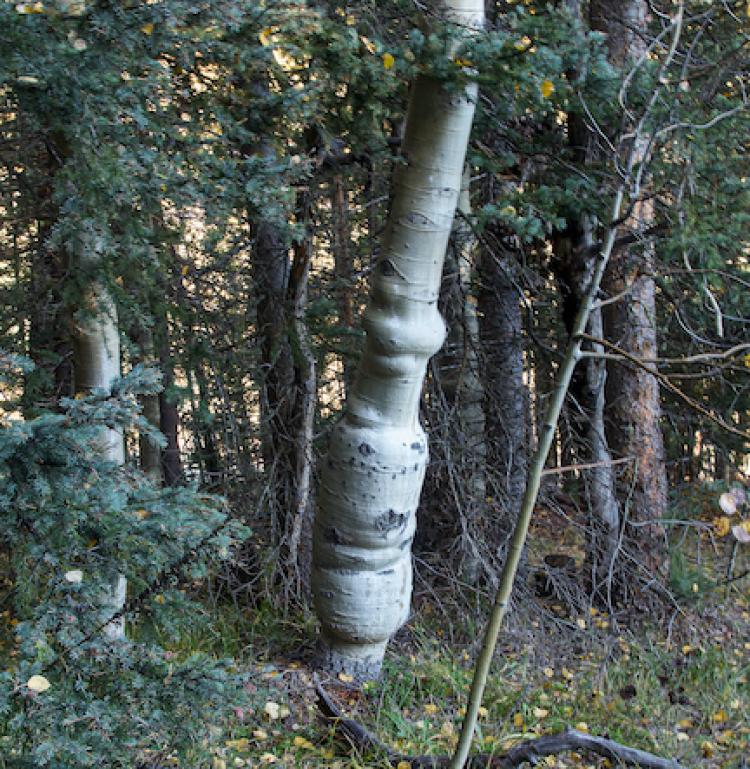Mysterious lumps and swollen bands on aspen
One puzzle leads to another question, as yet unanswered, about the cause
After a day of hiking the Mill Castle Trail in the West Elk Mountains I had returned to the trailhead, tired but exhilarated by my immersion in fall in the West Elk Wilderness.
I had been looking at and photographing aspen all day, but the aspen at the trailhead had conspicuous growths that I had not previously noticed. The aspen trunks had lumps and girdling swellings of all sizes, some of them covering over a vertical foot of the trunk. The cause of the growths was a puzzle.
My training as a geneticist suggested the hypothesis that a rare genetic mutation caused the growths. Some, but not all of the aspen at the trailhead had the odd growths. Perhaps I had encountered a mutant clone in proximity with a normal clone.

Above and at the top of the page: These unusual lumps and girdling bands were small twiggall fly galls that continued to grow with the tree. Photos by Jeff Mitton.
Remember that aspen roots thrust up numerous shoots or stems that look like individual trees but are parts of a single clonal individual. Separate clones can be distinguished with characters such as bark color, leaf shape and color, dark ticking on the bark, branch angle, etc.
But I saw no evidence that lumpy stems and normal stems were on separate clones. I put the genetic hypothesis aside.
When I returned to Boulder, I searched digitally to find what was known about the cause of the lumps and bands on aspen. Several articles described insects that lay their eggs near the ends of twigs. These include the poplar twiggall fly, Hexomyza shineri, and two species of beetles, the poplar gall saperda, Saperda inorata, and the poplar gall borer, Saperda calcarata.
When the fly or beetle eggs hatch, larvae begin to feed on the soft, growing tissues, which respond by imprisoning the larvae in firm galls that inadvertently protect them from predation. However, these insects do not lay eggs in the main trunk of the tree but at the ends of the slender growing twigs. Furthermore, the galls were small, for example the galls of twiggall flies are about 13 by 8 mm—that is not the sort of growth I saw in the field.
This puzzle was solved by Colorado State University Extension Fact Sheet 5.579, by Whitney S. Cranshaw. He mentioned that the twiggall fly is becoming more common in Colorado and warned that this is a concern because the galls continue to grow and swell as the tree grows.
Small galls grow continually to become permanent disfigurements. That is, if a fly lays several eggs on the leader (the vertical top of the trunk or stem) of a sapling the galls become larger lumps and some grow to a swollen band girdling the tree. Flies that lay eggs in the leader of the same trunk in subsequent years will add more lumps and swollen bands.
Twiggall flies are stout, dark and shiny, about one-sixth inch long. They can often be seen during the day resting on aspen leaves. They usually lay eggs on aspen, but occasionally their galls appear on cottonwoods as well.
These growths were usually covered with unbroken aspen bark. But some were leaking dark fluid that stained the bark. The dark fluid is the exudate from a Cytospora canker, a common fungus. Although the cankers and draining exudate are unsightly, their impact on the health of the aspen is small or negligible.
The twiggall fly is a native to Colorado, but its impact seems to be increasing. About 50 years ago, outbreaks were noticed in the Denver area, but since then observations have increased throughout the range of aspen in the Rocky Mountain region, and the increase has been described as dramatic in the Front Range.
Twiggall flies have few natural enemies. Chickadees are able to open the galls to consume larvae and pupae, and bugbees, Eurytoma contractura, are parasitic wasps that lay their eggs in the galls so that their larvae can consume fly larvae. The rate of parasitism varies from site to site, from 3% of galls to 94%.
It seems that the swollen bands now present another puzzle. Although we know how the lumps and bands form and we know about predators and parasites, we do not yet know why twiggall flies are increasing. Something has changed.

